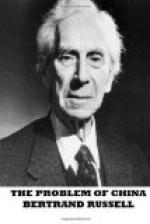[Footnote 63: On this subject George Gleason, What Shall I Think of Japan? pp. 174-5, says: “This paragraph concerns the iron and steel mills at the city of Hanyang, which, with Wuchang and Hangkow, form the Upper Yangtze commercial centre with a population of 1,500,000 people. The Hanyeping Company owns a large part of the Tayeh iron mines, eighty miles east of Hangkow, with which there are water and rail connections. The ore is 67 per cent. iron, fills the whole of a series of hills 500 feet high, and is sufficient to turn out 1,000,000 tons a year for 700 years. [Probably an overstatement.] Coal for the furnaces is obtained from Pinghsiang, 200 miles distant by water, where in 1913 five thousand miners dug 690,000 tons. Japanese have estimated that the vein is capable of producing yearly a million tons for at least five centuries....
“Thus did Japan attempt to enter and control a vital spot in the heart of China which for many years Great Britain has regarded as her special trade domain.”
Mr. Gleason is an American, not an Englishman. The best account of this matter is given by Mr. Coleman, The Far East Unveiled, chaps. x.-xiv. See below, pp. 232-3.]
[Footnote 64: See letter from Mr. Eugene Chen, Japan Weekly Chronicle, October 20, 1921.]
[Footnote 65: The Notes embodying this agreement are quoted in Pooley, Japan’s Foreign Policies, Allen & Unwin, 1920, pp. 141-2.]
[Footnote 66: On this subject, Baron Hayashi, now Japanese Ambassador to the United Kingdom, said to Mr. Coleman: “When Viscount Kato sent China a Note containing five groups, however, and then sent to England what purported to be a copy of his Note to China, and that copy only contained four of the groups and omitted the fifth altogether, which was directly a breach of the agreement contained in the Anglo-Japanese Alliance, he did something which I can no more explain than you can. Outside of the question of probity involved, his action was unbelievably foolish” (The Far East Unveiled, p. 73).]
[Footnote 67: The demands in their original and revised forms, with the negotiations concerning them, are printed in Appendix B of Democracy and the Eastern Question, by Thomas F. Millard, Allen & Unwin, 1919.]
[Footnote 68: The texts concerned in the various stages of the Shantung question are printed in S.G. Cheng’s Modern China, Appendix ii, iii and ix. For text of Ishii-Lansing Agreement, see Gleason, op. cit. pp. 214-6.]
[Footnote 69: Three books, all by Americans, give the secret and official history of this matter. They are: An American Diplomat in China, by Paul S. Reinsch, Doubleday, Page & Co., 1922; Democracy and the Eastern Question, by Thomas F. Millard, Allen & Unwin, 1919; and China, Captive or Free? by the Rev. Gilbert Reid, A.M., D.D. Director of International Institute of China, Allen & Unwin, 1922.]




